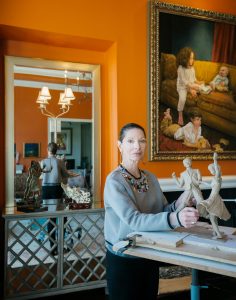Bulka: 9 Artists to Know

BY ALLISON STICE BULKA
Special to Savannah Magazine
Fran Kaminsky
“There are lots of rules in a school setting,” says Fran Kaminsky, former chief academic officer of South University. “You’re managing students and teachers and schedules, you’ve got accreditation you’ve got to think about, and whether you’re meeting standards. That’s very different than: ‘Here’s a lump of clay: What are you going to do with it?’”
It wasn’t until after her retirement in 2001 that Kaminsky’s new passion began to take form. An admirer and collector of Glenna Goodacre and Frank Hart, she was drawn to the medium by her love of portraits. But where to start? A college art class seemed too intimidating. A workshop, however, she could handle.
First encouraged and mentored by renowned Savannah-based sculptor Susie Chisholm, known locally for the Johnny Mercer sculpture in Ellis Square, and the late Judy Mooney, Kaminsky now focuses on her figures during weeklong retreats several times a year in North Carolina.
These retreats are where most of her clay sculptures, imbued with movement and mystery, spring to life. Her work is often based on photographs that catch her eye and seem to have a story behind them: a girl hoisting herself out of the swimming pool, a couple doing the G.I. Jive, a child jumping rope or a woman about to be carried away by a bundle of balloons. With every piece, Kaminsky carefully plans what the viewer can and cannot see.
Unlike the more fragile and particular ceramics she started with, oil-based clay allows her to tweak and bend and shift until she’s content. “I’m trying to not be quite so clean and neat. I like the look of the rougher surfaces, but I tend to smooth it. So I have to stop myself.”
When Kaminsky decides she likes a work enough to cast it in bronze, it’s time to think about patina. She typically considers texture and light, though sometimes the sculptures decide for themselves: A woman twirling in a dress in a piece called Gorgeous could only be wearing red, Kaminsky reasoned, so that’s the shade in which she was cast.
“When you’re painting, it’s really about color and getting color right to make it look real,” Kaminsky says. “When you’re sculpting, you’re making a three-dimensional object that is real. You don’t have to worry about color for eyes and skin and hair. I just create the illusion, and you’ll do the rest.”
